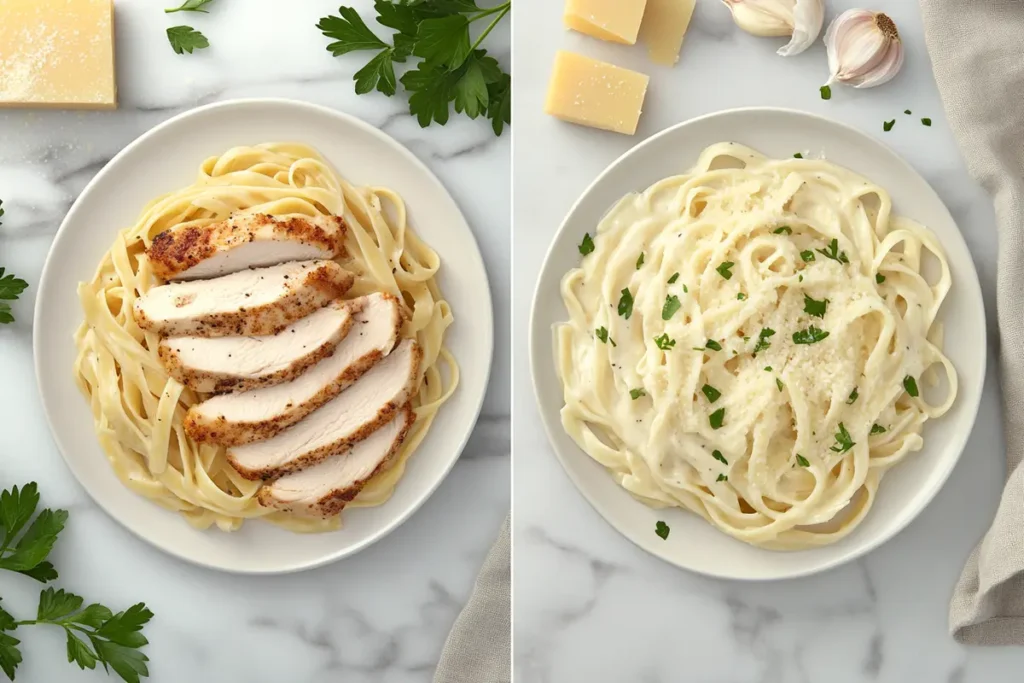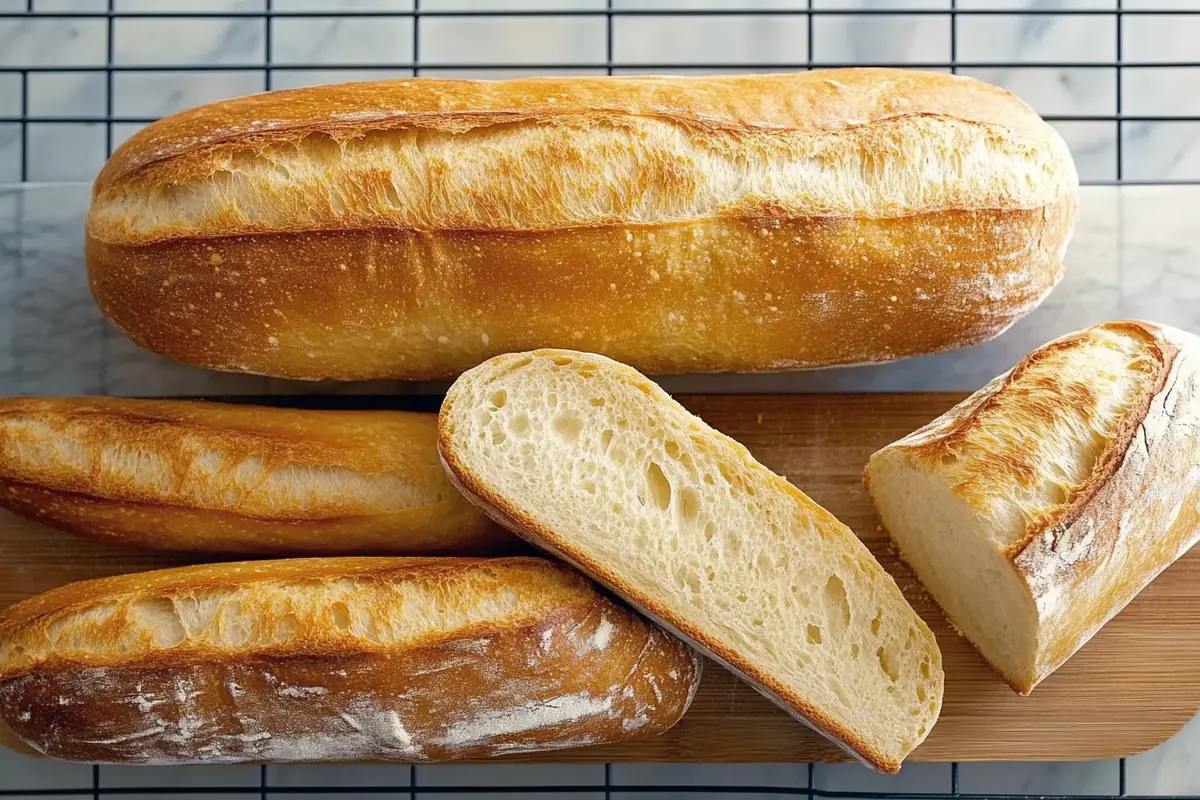What is the difference between Chicken Alfredo and Fettuccine Alfredo? Many pasta lovers wonder how these two creamy dishes compare. While both feature a rich Alfredo sauce, they differ in ingredients, preparation, and cultural influence. This guide will explore everything you need to know about these two classic dishes!
Table of Contents
Introduction and Overview
What is Alfredo Sauce?
Alfredo sauce is the creamy foundation that ties both Chicken Alfredo and Fettuccine Alfredo together. Its origins date back to early 20th-century Rome when Alfredo di Lelio, an Italian restaurateur, created the dish to please his wife, who had lost her appetite after childbirth. The original recipe was deceptively simple, combining butter, Parmesan cheese, and fresh pasta. Over time, the sauce evolved, especially in American kitchens, with heavy cream becoming a staple ingredient.
This iconic sauce is renowned for its rich and silky texture, making it an irresistible base for a variety of pasta dishes. From the earthy nuttiness of Parmesan to the smoothness of butter, Alfredo sauce is as comforting as it is versatile.
Why Do Alfredo Dishes Differ?
Despite their shared roots in Alfredo sauce, Chicken Alfredo and Fettuccine Alfredo diverge in notable ways. These differences stem from ingredient additions, cultural adaptations, and regional preferences. While Fettuccine Alfredo sticks closely to the original recipe, focusing on simplicity and indulgence, Chicken Alfredo takes it up a notch by adding juicy, protein-packed chicken to the mix.
As a result, these dishes cater to slightly different palates. If you’re craving a lighter, more traditional experience, Fettuccine Alfredo is the go-to. But for those who enjoy a heartier, protein-rich twist, Chicken Alfredo fits the bill perfectly. Their popularity in Italian-American cuisine has only cemented their place as household favorites across the globe.
Exploring Chicken Alfredo
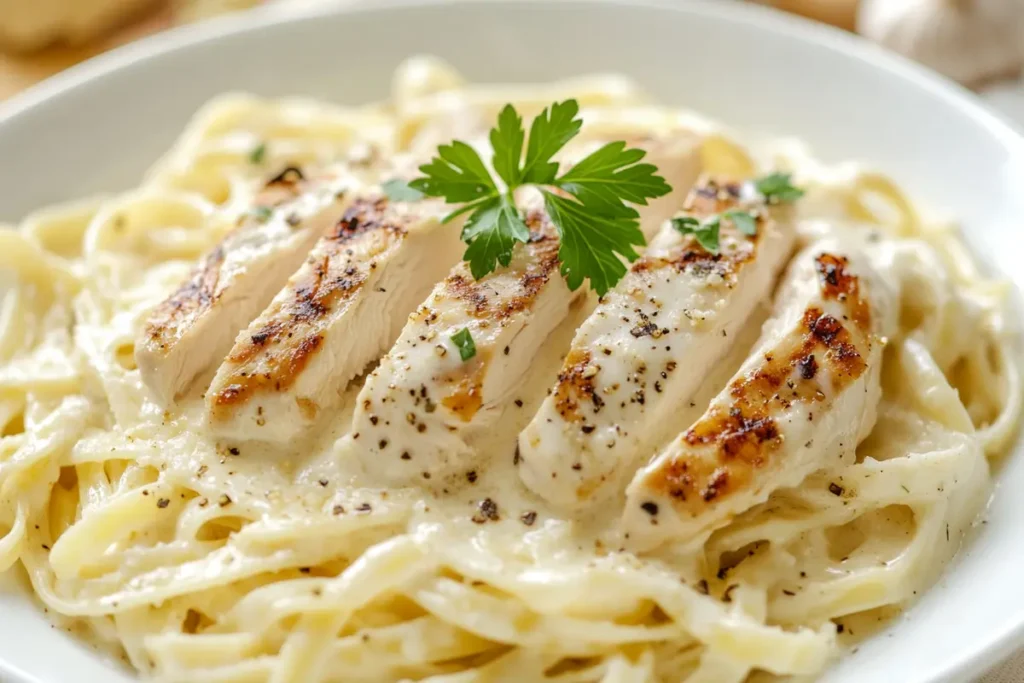
What is Chicken Alfredo?
Chicken Alfredo is a classic Italian-American dish that combines tender chicken, creamy Alfredo sauce, and fettuccine pasta. This hearty meal is a favorite for its rich flavors and satisfying texture. The dish elevates the traditional Fettuccine Alfredo by introducing seasoned chicken, creating a protein-packed version that’s both indulgent and filling. Whether enjoyed at a cozy family dinner or as a restaurant favorite, Chicken Alfredo is a quintessential comfort food that has captured hearts worldwide. Its versatility allows for endless adaptations while still holding true to its creamy, savory essence.
Common Ingredients in Chicken Alfredo
- Chicken Breast: The star of the dish, chicken breast is often seasoned, seared, or grilled to golden perfection. It adds a protein boost and hearty bite to the meal.
- Cream: A rich and velvety heavy cream forms the base of the Alfredo sauce, giving it that signature smooth texture.
- Parmesan Cheese: Freshly grated Parmesan cheese provides the nutty, tangy flavor that balances the creaminess of the sauce.
- Garlic: The inclusion of garlic adds a fragrant depth and a slight zing, enhancing the sauce’s complexity without overpowering it.
- Butter and Olive Oil: These fats help cook the chicken and add richness to the sauce.
- Fettuccine Pasta: While the chicken is a centerpiece, fettuccine remains a vital component, offering the perfect shape to hold the creamy sauce.
How is Chicken Alfredo Made?
- Cook the Chicken: Start by seasoning the chicken breast with salt, pepper, and optional Italian herbs. Sear it in a skillet with butter or olive oil until golden brown on both sides, then set it aside to rest.
- Prepare the Sauce: In the same skillet, sauté minced garlic until fragrant. Add heavy cream and let it simmer gently. Gradually stir in Parmesan cheese, allowing it to melt and thicken the sauce.
- Cook the Pasta: Boil the fettuccine in salted water until al dente. Reserve some pasta water to adjust the sauce’s consistency, if needed.
- Combine: Slice the chicken and toss it into the skillet with the sauce. Add the cooked fettuccine and mix everything until evenly coated. Adjust seasoning with salt and pepper, garnish with parsley, and serve hot.
Variations: Grilled vs. Baked Chicken
Chicken Alfredo offers room for customization. Grilled chicken adds a smoky, slightly charred flavor, making it a popular choice for summer dishes. Baked chicken, on the other hand, provides a juicier texture and ensures even cooking. Some recipes even call for breaded chicken for added crunch, but these variations ultimately depend on personal preference.
Nutritional Value of Chicken Alfredo
- Calories: A standard serving of Chicken Alfredo contains around 1,200–1,400 calories, depending on portion size and ingredients.
- Protein: Thanks to the chicken, this dish delivers a solid protein punch, typically 35–45 grams per serving.
- Carbohydrates: The pasta contributes approximately 60–80 grams of carbs, making it a hearty meal for energy.
- Fat: The creamy sauce adds about 40–50 grams of fat, much of it coming from cream and butter.
- Sodium: Depending on the cheese and seasoning, sodium levels can vary but often reach 1,000 mg or more per serving.
While it’s a calorie-dense dish, Chicken Alfredo can be lightened up by using low-fat cream, whole-grain pasta, or grilled chicken. It’s a satisfying meal that combines indulgence with sustenance, making it a favorite for both casual and special occasions.
Understanding Fettuccine Alfredo
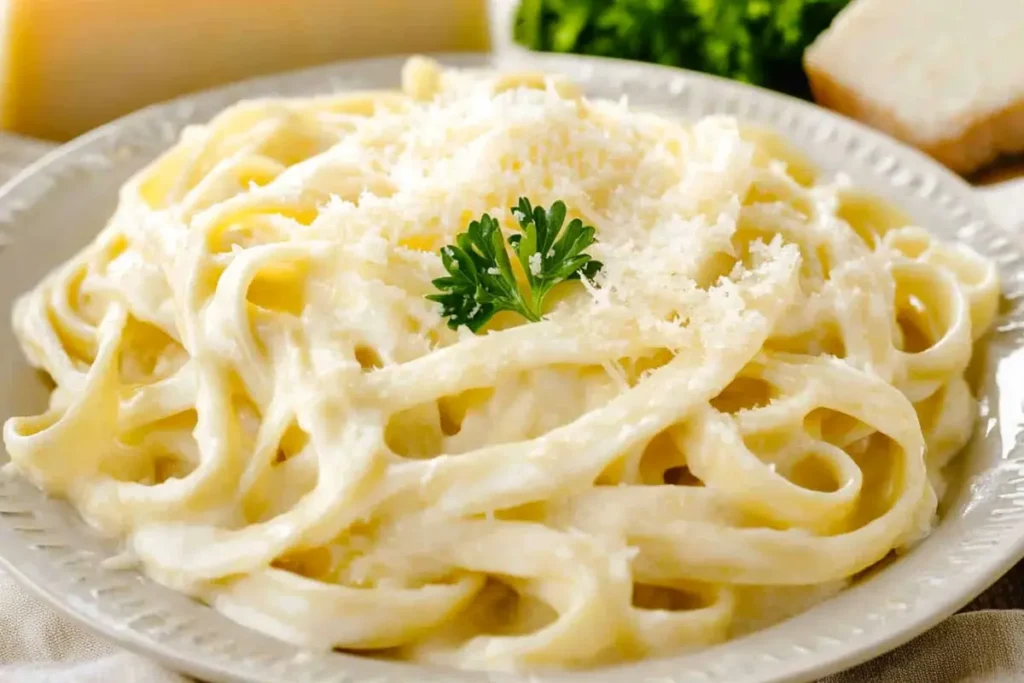
What is Fettuccine Alfredo?
Fettuccine Alfredo is a simple yet luxurious Italian pasta dish that highlights the beauty of minimal ingredients. It originated in Rome, where Alfredo di Lelio crafted the recipe in the early 1900s as a comforting meal for his wife. Traditionally made with only fettuccine pasta, butter, and Parmesan cheese, it’s a dish that relies on the quality of its components to deliver a creamy, indulgent flavor. Unlike Chicken Alfredo, Fettuccine Alfredo is known for its light, buttery sauce that allows the freshness of the pasta to shine through.
Classic Ingredients of Fettuccine Alfredo
- Butter: High-quality butter forms the creamy base of the dish. In the traditional Roman version, unsalted butter is melted to coat the pasta evenly.
- Parmesan Cheese: Freshly grated Parmesan cheese is the star ingredient, providing a sharp, nutty flavor and acting as a natural thickener for the sauce when combined with pasta water.
- Fresh Pasta: Authentic Fettuccine Alfredo uses fresh fettuccine pasta made from eggs and flour. Its tender texture absorbs the sauce beautifully, creating a perfect balance of flavors.
How is Fettuccine Alfredo Made?
- Cook the Fettuccine: Begin by boiling fresh fettuccine pasta in salted water. Reserve a cup of the starchy pasta water before draining, as it will be crucial for the sauce.
- Melt the Butter: In a large pan, melt butter over low heat. Be careful not to brown it, as you want the butter to remain smooth and creamy.
- Add Parmesan Cheese: Gradually stir in freshly grated Parmesan cheese. Mix continuously to create a creamy consistency.
- Combine with Pasta: Add the cooked fettuccine to the pan. Toss the pasta in the butter and cheese mixture, adding small amounts of the reserved pasta water until the sauce clings to the noodles perfectly.
- Garnish and Serve: Plate the pasta immediately, garnishing with additional Parmesan cheese and a sprinkle of parsley if desired.
Nutritional Value of Fettuccine Alfredo
- Calories: A standard serving contains approximately 800–1,000 calories, depending on portion size and ingredient quantities.
- Carbohydrates: The pasta contributes around 70–90 grams of carbs, providing a significant energy boost.
- Protein: Parmesan cheese adds about 15–20 grams of protein, depending on how much is used.
- Fat: The butter and cheese contribute 40–50 grams of fat, making this dish a rich treat.
- Sodium: Parmesan cheese naturally contains sodium, resulting in about 700–900 mg per serving.
Key Differences Between Chicken Alfredo and Fettuccine Alfredo
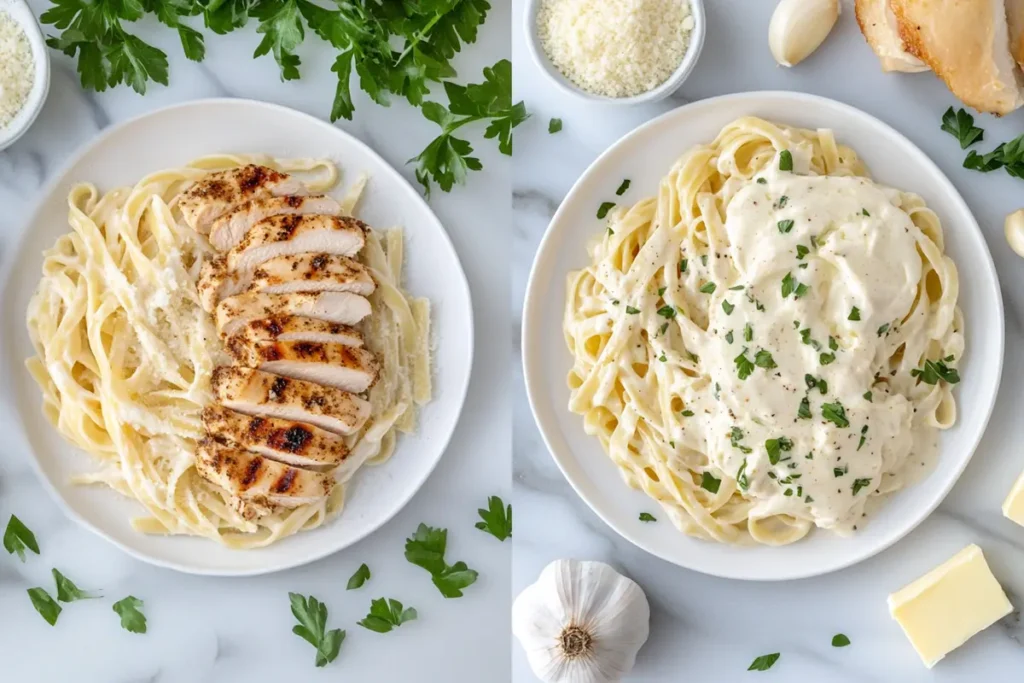
Main Ingredient Differences
Presence of Chicken in Chicken Alfredo
One of the most striking differences between Chicken Alfredo and Fettuccine Alfredo lies in the use of chicken. In Chicken Alfredo, tender, seasoned chicken breast takes center stage. Whether grilled, baked, or pan-seared, the chicken adds a savory, hearty component that complements the creamy Alfredo sauce. Its inclusion not only boosts the dish’s protein content but also adds a chewy texture, making it a more filling and robust meal.
The chicken’s flavor varies based on its preparation—grilling imparts a smoky undertone, while baking enhances its tenderness. Regardless of the method, the chicken enriches the dish by balancing the creaminess of the sauce with a meaty, satisfying bite. Without it, Chicken Alfredo would simply be another variation of Fettuccine Alfredo.
Focus on Pasta and Sauce in Fettuccine Alfredo
On the other hand, Fettuccine Alfredo is a celebration of simplicity, where the pasta and sauce are the true stars. Authentic Fettuccine Alfredo relies on the interplay of just three ingredients—fettuccine, butter, and Parmesan cheese. Unlike its counterpart, it doesn’t rely on any protein to enhance its appeal. Instead, the dish focuses on the rich, silky sauce clinging to perfectly cooked pasta.
This minimalist approach allows diners to savor the purity of the Alfredo sauce and the tender texture of fresh fettuccine. The absence of chicken or other add-ons highlights the craftsmanship behind the sauce, as its consistency and flavor must be perfect to carry the dish. Fettuccine Alfredo is the epitome of “less is more” in Italian cuisine.
Flavor Profile Comparison
How Chicken Impacts the Flavor in Chicken Alfredo
The addition of chicken to Alfredo sauce introduces a savory depth and enhances the overall flavor profile. The seasoned meat often carries hints of garlic, herbs, or even a smoky char, which blend harmoniously with the creamy sauce. This interplay between the chicken and the Alfredo sauce creates a dynamic dish that feels more complex compared to its simpler cousin.
Rich Simplicity of Fettuccine Alfredo
In contrast, Fettuccine Alfredo is all about indulgence through simplicity. The buttery, cheesy sauce coats the pasta in a velvety layer, offering a rich, comforting flavor with every bite. There’s nothing competing with the sauce—no protein, no additional seasonings—just pure, unadulterated creaminess. This makes Fettuccine Alfredo a dish that feels lighter in flavor yet equally satisfying.
Cultural and Regional Variations
Italian vs. American Adaptations
Both dishes have undergone significant transformations as they crossed the Atlantic. In Italy, Fettuccine Alfredo remains true to its roots, prepared simply with butter and Parmesan cheese. It’s often considered a dish for special occasions rather than a common everyday meal. Chicken Alfredo, on the other hand, is primarily an Italian-American creation. While it retains the essence of Alfredo sauce, the addition of chicken, cream, and garlic reflects American tastes for heartier, protein-packed meals.
In American cuisine, Chicken Alfredo is often embellished with other ingredients like broccoli, mushrooms, or even sun-dried tomatoes, further moving it away from its Italian origins. These adaptations highlight the cultural preference for bold, varied flavors compared to the restrained elegance of traditional Italian cooking.
Common Side Dishes Served with Each
Chicken Alfredo, being a heavier dish, is typically paired with lighter sides like steamed vegetables, a crisp green salad, or garlic bread. These accompaniments help balance the richness of the dish.
Fettuccine Alfredo, in its simpler form, is often served as a standalone dish or accompanied by a glass of sparkling water and a wedge of lemon for freshness. In Italy, it may also be served as a primo (first course) before the main meal.
Popularity and Restaurant Offerings
Why Chicken Alfredo is a Favorite in the U.S.
Chicken Alfredo is one of the most popular dishes on Italian-American restaurant menus in the United States. Its appeal lies in its ability to combine creamy, comforting flavors with protein, making it feel like a complete meal. The addition of chicken not only caters to American preferences for meat-based dishes but also makes it suitable for casual dinners, family gatherings, and even meal prep.
Many chain restaurants, such as Olive Garden, have embraced Chicken Alfredo as a signature dish, often serving it in generous portions to match the American appetite. Its hearty, satisfying nature ensures it remains a customer favorite.
Fettuccine Alfredo’s Place on Classic Italian Menus
Fettuccine Alfredo, while less common in traditional Italian-American eateries, retains its charm as a quintessential Italian dish. It’s more frequently found in authentic Italian restaurants or prepared at home by enthusiasts of classic Italian cuisine. Chefs often highlight the simplicity and authenticity of the dish, showcasing its elegance in its purest form.
In Italy, Fettuccine Alfredo isn’t a staple menu item but is cherished as a traditional comfort food, appreciated for its rich flavors and connection to Italian culinary history.
Frequently Asked Questions
Is Fettuccine Alfredo the same as Chicken Alfredo?
No, Fettuccine Alfredo and Chicken Alfredo are not the same. While both dishes use Alfredo sauce as their base, Fettuccine Alfredo focuses on the simplicity of butter, Parmesan cheese, and fettuccine pasta. Chicken Alfredo, on the other hand, includes seasoned chicken as a key ingredient, making it a heartier dish.
What can I use instead of fettuccine for Chicken Alfredo?
If you don’t have fettuccine on hand, you can substitute it with other types of pasta. Popular options include linguine, spaghetti, or penne. Shorter pasta shapes like farfalle (bowtie) or rigatoni also work well, as they hold the Alfredo sauce beautifully and offer a different texture to the dish.
What makes Fettuccine Alfredo unique?
Fettuccine Alfredo stands out for its minimalist approach, relying on just butter, Parmesan cheese, and pasta water to create its creamy sauce. The richness of these ingredients combined with the smooth texture of fresh fettuccine pasta makes it unique. Its simplicity allows the natural flavors of the ingredients to shine, creating a dish that’s indulgent yet elegant.
Why is it called Fettuccine Alfredo?
The dish is named after its creator, Alfredo di Lelio, a Roman chef who introduced it in 1914. He originally made it to comfort his wife after childbirth. The combination of butter and Parmesan melted over fettuccine pasta became so beloved that it was named in his honor and popularized worldwide.
Do Italians put chicken in Alfredo?
No, Italians typically do not put chicken in Alfredo. The traditional Italian version of Alfredo sauce is much simpler, focusing solely on butter, Parmesan cheese, and fresh pasta. Adding chicken is an American adaptation that caters to the preference for heartier, protein-rich meals, which is not part of traditional Italian cuisine.
Which dish is healthier: Chicken Alfredo or Fettuccine Alfredo?
When comparing the two, Fettuccine Alfredo is generally lighter in calories since it doesn’t include chicken. However, it is still rich due to the butter and cheese. Chicken Alfredo, while higher in calories due to the added protein, provides more nutrients like iron and a significant amount of protein.
To make either dish healthier, consider substituting whole-grain pasta, using reduced-fat cream, or adding vegetables like broccoli or spinach. Ultimately, both dishes are indulgent treats, and moderation is key to enjoying them as part of a balanced diet.

